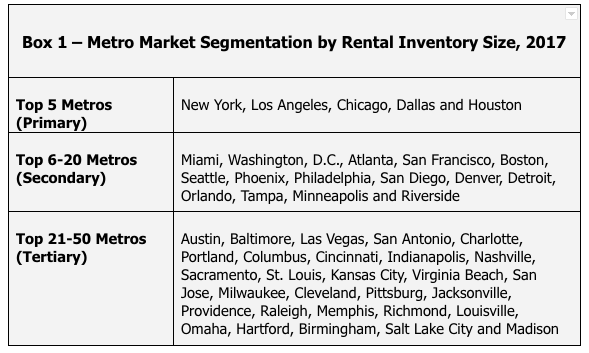Millennial Apartment Renters Flock to Smaller Urban Centers

Smaller metros offer a balance of affordable apartment rentals and growing economic opportunity that is increasingly catching the eye of transient Millennials. Millennials comprise an increasing share of the adult rental population moving from larger to smaller urban centers across asset types.
Millennials Flock to Small Asset Multifamily
A predominant theme in multifamily trends of late has been Millennials jettisoning major urban centers in favor of smaller regional metros. A combination of affordable rental options, urban lifestyle and abundant job opportunities has been a powerful sales-pitch in attracting younger renters.
For a closer look at this phenomenon, and building upon our recent research on U.S. renter growth by age segments, this blog post examines the distribution of Millennial demand along dimensions of metro and building size. We utilize Pew Research Center’s cohort classifications, which define Millennials as those born from 1982 to 1996. For a quick overview across U.S. urban areas we look at metro segments based on MSA size (see Box 1).
As shown below, smaller, less expensive metros attract the youngest of apartment renters. Millennials comprise an increasing share of the adult (18 years and older) rental population moving from the Top 5 metros to the Next 15 and Next 30 metros across asset types, based on Census Bureau data.¹
(Please click around for detailed chart information)
In 2017, Millennials accounted for an estimated 44% of all renters in small asset multifamily in the Top 5 metros. This figure rose to 48% in the Next 15 metros and peaked at 50% in the Next 30 metros. In comparison, Millennials form lower shares of adult renters within large asset multifamily across all metro segments. The segment topped out at 43% in the Next 15 metro areas.
Millennial Renting on the Rise in Smaller Urban Centers
Millennials saw their share of the total adult renter population decline slightly between 2015 and 2017, in part due to the emergence of Gen Z. However, over the same period, several smaller metros areas still managed to display impressive Millennial gains.
As depicted below, among the nation’s largest 50 metro areas, those with the most sizeable gains in their share of Millennials in small asset multifamily were largely in the Next 30 segment. Cleveland and Nashville headlined the group, with share increases of 4.9% and 4.6%, respectively.
(Please click around for detailed chart information)
For large asset multifamily, Nashville, Raleigh, Birmingham, Salt Lake City, Columbus, and Portland showed the highest gains in their shares of Millennials, as shown below. Among the Next 15 segment, Seattle and Denver also experienced impressive growth. Unsurprisingly, the fastest-growing metro area in the nation, San Jose, attracted an increasing share of Millennial renters despite its high rental prices.
(Please click around for detailed chart information)
For property owners and managers, the Millennial movement to smaller metros is a developing story and represents new growth opportunities. In future blogs, we will examine the migration patterns of this renter segment to identify emerging hotspots.
1 All data is sourced from the American Community Survey (ACS), unless otherwise stated. ACS statistics are sample-based estimates of the compositional profile of the total population in the given year of data collection, and include a margin of error.


